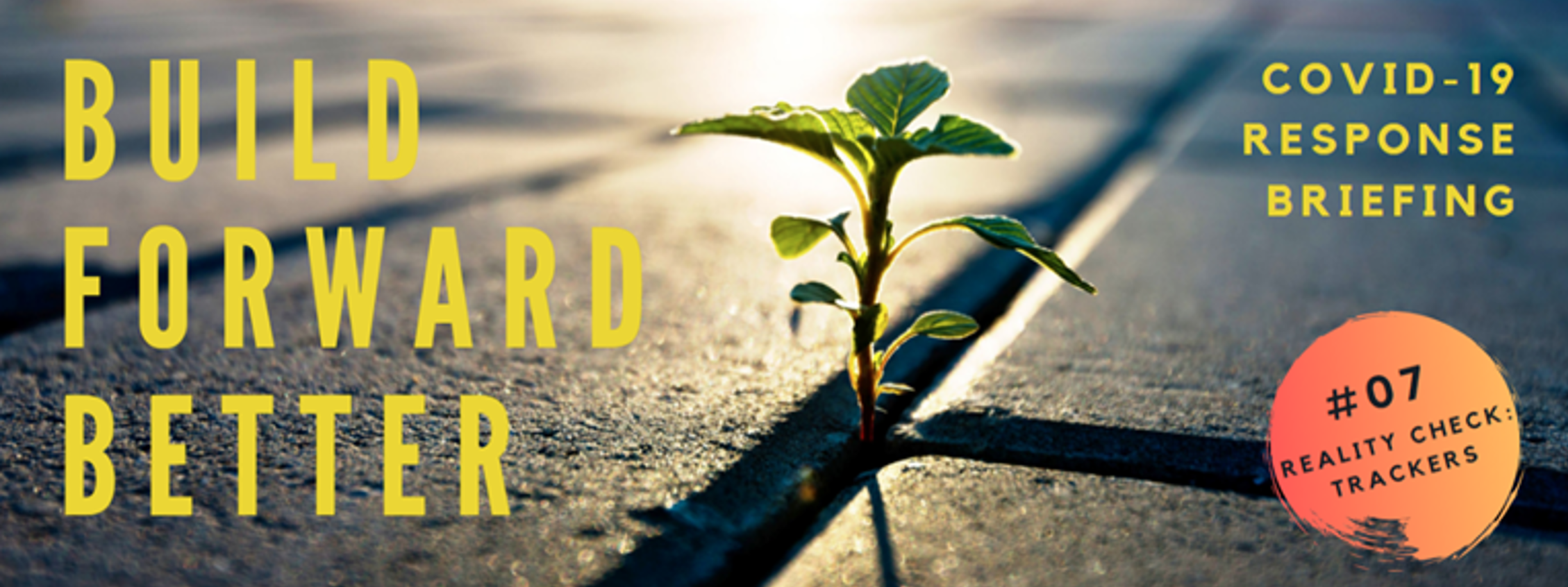Build Forward Better after COVID-19: Briefing #07 Reality Check – Trackers

Within less than a year, the COVID-19 pandemic has changed how countries around the world respond to national priorities and the global threats of the climate and biodiversity crises. Green Recovery has become the key term for a future-orientated and sustainable economic response to the pandemic. Until now, the Build Forward Better Briefings have featured Green Recovery news from governments and non-state actors expressing their commitment and measures taken. As we enter the second year of the pandemic, it is time to conduct a reality check on the announcements by countries to pursue a Green Recovery.
Over the next two issues, we will first take a closer look at analytical tools that provide orientation on where countries stand, before highlighting good practices that may pave the way forward. For this briefing, we have reviewed tracking tools that monitor the COVID-19 response measures by governments with special attention to their environmental impact. The briefing explains how these trackers function, how they conceptualize Green Recovery, as well as what they can offer, what they lack and how they can be used.
As there is no globally accepted conceptualization of what a Green Recovery entails, the types of response measures that are currently being developed under this label show a large variety, as well as the assessments of their “greenness”. Nonetheless, most analyses on the progress of a Green Recovery have two important features in common. Firstly, they share the aim of providing an empirical basis for the international dialogue on transformative pathways towards a low-carbon and resilient economy. Secondly, their results overwhelmingly show that the global COVID-19 response has been far from living up to this aim that many governments have declared to pursue (see Vivid Economics, OECD, IISD). According to Vivid Economics, only four percent of announced stimulus measures in the 25 economies examined can be considered as improving biodiversity or preserving ecosystems, opposed to 31 percent flowing into carbon-intensive sectors.
While diving into the details is essential to get a sense of where we are headed, it is important to keep in mind that tracking tools depend on reliable data, typically reduce complexity and offer only a temporally limited view. Instead of building on a normative conceptualization of Green Recovery, some trackers define the concept only implicitly by means of the indicators used in their analysis. Instead, a Green Recovery must be built on the notion of an inclusive Green Economy that is low-carbon, biodiversity-friendly, resilient, resource-efficient, socially just and inclusive and of course aligned with the SDGs.
As stated in the guide “Green Recovery for Practitioners”*, a Green Recovery needs to set the “course for long-term structural reforms and a transformative shift towards sustainability, biodiversity protection, resilience and climate neutrality.” An ideal tracking tool should thus cover these dimensions, not least to provide orientation for the design of a Green Recovery. Our analysis shows that, despite their limitations, these trackers can provide a factual basis for keeping up the pressure on policymakers to follow through with the transformation towards a sustainable future in the face of the pandemic.
We hope you find this BFB Briefing insightful and look forward to your feedback and thematic suggestions for future issues. The next BFB Briefing will build on this reality check by discussing potential good practices of implementing a Green Recovery in partner countries.
Many thanks to our colleagues from UNEP who contributed to this issue.
Best regards,
IKI Projects BioFrame, CDCPIII, GET, SDG-RI & SPA**
* This guide provides a practical framework that captures the key elements of a green recovery to inform the work of economic advisors supported by the NDCP and partner organizations.
** This briefing is a collaborative product by several GIZ projects funded by the International Climate Initiative (IKI) of the Federal Ministry for the Environment, Nature Conservation and Nuclear Safety (BMU): Support Project for the Design and Implementation of the New Global Biodiversity Framework (BioFrame); Capacity Development for Climate Policy in Southeast & Eastern Europe, South Caucasus and Central Asia, Phase III (CDCPIII); Green Economy Transformation in Cooperation with the Partnership for Action on Green Economy (GET); Support Project for SDG Review and Implementation Processes (SDG-RI); Support Project for the Implementation of the Paris Agreement (SPA). The opinions expressed are those of the authors and do not necessarily coincide with views of the organization.
Green Economy Transformation in Kooperation mit der Partnership for Action on Green Economy (PAGE), Globale Vorhaben, Konventions-/Sektor-/Pilotvorh

